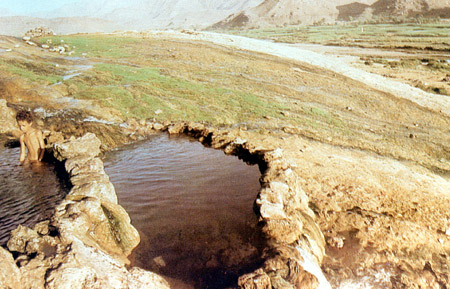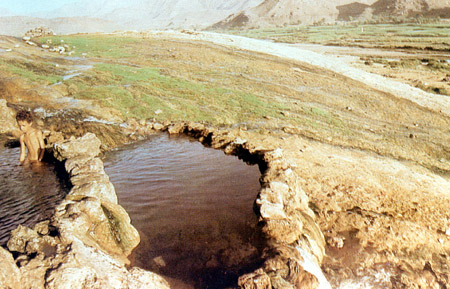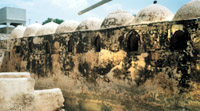
Yemeni Hot Springs Derelict Present & Uncertain Future [Archives:2001/34/Health]
August 20 2001

Farouk Al-Kamali
Yemen Times
Hot springs are subjected to misuse and debilitation which led to their destruction amidst the negligence of the Ministry of Tourism and its offices in the governorates. It is cause for alarm when a hot springs like the one in the Damat area got drained and the other one in al-Sukhnah turned to be the property of the ruling party the GPC and not the Ministry of Tourism.
The newly-created Ministry of Tourism has to render care to this significant resource. In addition the private sector has to contribute in the development of these hot springs and raise them to the required standard. More than 50 hot springs exist nationwide and the most well-known ones are as follows:
– Al-Sukhnah hot spring located 40 km to the southwest of Hodaidah
– Damat hot spring located 40 km from Damat village in Dhale’a Governorate
– Ali Aniss hot spring located 90 km to the west of Hodaidah
– Alasi hot spring located to the east of Dhamar city
– Karesh hot spring located 90 km to the east of the city of Taiz
In fact, these hot springs are still used in a primitive way by the citizens and up to this very moment there is no investment in these hot springs. Similarly, the necessary facilities required for these hot springs are unavailable.
An issue of major concern in this regard is that some influential personalities and sheikhs seized these springs and made of them as their own properties. An evident illustration of that is the al-Sukhnah hot spring in Hodaidah which belongs to the ruling party (the General People Congress) and not the Ministry of Tourism.
Medical gains of hot springs
Hot springs have so many benefits, particularly for skin illnesses and allergies, eye troubles, rheumatism and blood circulation illnesses. They are also so beneficial for the aging people since it refreshes them and makes them recover from certain aging-related illnesses. Furthermore, it is believed that hot springs revitalize the sexual potency of men.

Mr. Abdulqawi Sallim Director-General of the Tourism Office in Taiz talked about the hot springs in Taiz and said that the there are so many hot springs in Taiz, the most important of which are the following:
– Ali Shuba hot spring located in the southwest of Taiz in al-Barakani area. However, it has been subjected to damage within the last couple of years.
– Raisyan hot spring located in Maqbana district is presently so primitive and always subjected to damage due to the rainfalls. This hot spring is the destination of many people on a quest for remedy and recreation.
Al-Twair hot spring, located also in Maqbanah, is composed of many permanent hot springs. However, they gradually drained during the drought season. Unfortunately, these hot springs are still exposed and subjected to damage during the rainy season.
Hot springs in Ibb
The Ibb Governorate is one of the most important destinations for people looking for physical medication. However, to make wise use of these hot springs large amount of capital are required for investing in such projects with the view of establishing complete medical facilities at each place where hot springs are available.
Mr. Amin Juzailan Director-General of Tourism Office in Ibb said that the most important hot springs in Ibb are as follows:
– Al-Sahair in Odain district
– Bahri Mountain hot spring also in Odain district
– Al-Aslum in Hazm Odain district
Moreover, there are many hot springs in al-Qafar district such as Jubran, al-Dhafad’a, al-Adib and Ali al-Asfal hot springs. These are small hot springs which are usually used by the inhabitants of those districts.
Hot springs in Hodaidah
Mr. Abdulah al-Kuli, Director of Tourism Office in Hodaidah, noted that the al-Sukhnah hot spring is the most significant one in Hodaidah. He further added that Imam Ahmed used to go to this hot spring for treating rheumatism from which he was suffering. Moreover, Imam Ahmed ordered the establishment of a palace consisting of many residential sections and a reception section as well. In addition several facilities were created such as offices for the army, a building for cable services, a mosque and a small airfield.

Mr. Mohammed Abdurahman Ahmed said that the Governorate of Lahaj enjoys many natural and tourist attractions. He added that many areas at the Governorate could be turned to natural conservation owing to the availability of rare wild plants, birds and animals.
As far as the hot springs in Lahaj is concerned, there are many hot springs in the Governorate like Shara’ah hot spring in the Halimene district which is visited by many people for medication purposes. Moreover, this hot spring has became a locality for holding cultural and artistic festivals.
Another hot spring here is al-Ayumi hot springs in Karesh in Qabitah district which is also visited by many people, although it is primitive and needs many facilities. Moreover, this site is a good attraction for recreation and spending vacations.
Hot springs in Dhale’a
The Governorate of Dhale’a has many hot springs, the most important which is al-Darwesh, al-Hassan, al-Imam and Atef hot springs. An issue of major concern is that these hot springs are misused and some day they may entirely become drained.
A committee from the Parliament has previously visited the area and the hot springs there and reported its findings to the cabinet. The recommendations of the committee stressed the necessity to rescue and invest the hot springs there, particularly Damet hot spring. The report produced by the committee is a good one and its recommendations should be taken into account.
How to boost tourism for medical purposes?
Tourism for medical purposes is still so primitive in Yemen and unorganized. Moreover, the hot springs-goers are usually ordinary people who believe that these hot springs are beneficial for them. Yet it seems that Imam Ahmed is the only important personality who sought treatment in a Yemeni hot spring and this could be the reason behind the negligence of the hot springs. Furthermore, neither the public nor the private sector enterprises has attempted to invest in hot springs, despite their potential earnings.
Similarly, there are so many defects regarding the publicizing of these hot springs which is completely absent. Thus, the government has to attach importance to this resource, on the one hand, and the people themselves have to be aware of their importance and how to preserve such natural gifts, on the other.
——
[archive-e:34-v:2001-y:2001-d:2001-08-20-p:./2001/iss34/health.htm]


